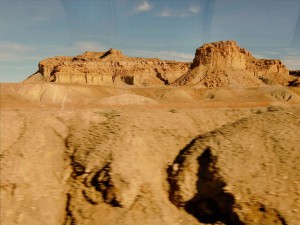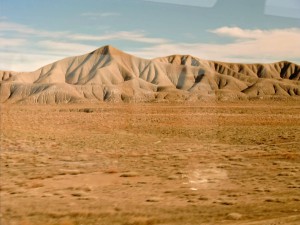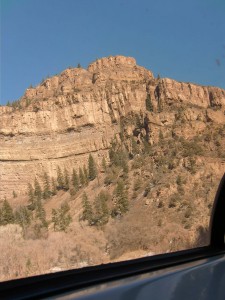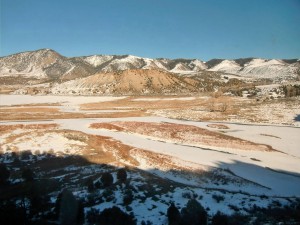IN SEARCH OF SNOW – ON TO THE ROCKIES
IN SEARCH OF SNOW
This is the third in a series of articles about traveling by rail in search of snow.
ON TO THE ROCKIES
By Charles N. Stevens
Photos by Dolores Seidman
During the night our train, the Zephyr, had slipped through Salt Lake City and Provo, Utah. By the time we wake up and make our way to the dining car for breakfast we are rolling through Helper, Utah, steam from their coal mining operations billowing into the chill morning air. With a backdrop of patchy snow and frosty shrubs, hundreds of railroad cars loaded with coal wait to be hauled away.
Beyond Helper the snow ends, replaced by the lifeless gray hills and bluffs of the high desert. Jagged gray-blue mountains lie in the distance, the clear sky above them tufted with cirrus clouds. Winter-bare cottonwood trees stand where moisture is available and junipers dot the higher hills, but most of the land is covered with sage or grass so short that cattle would have a hard time feeding on it. Ice rims the muddy pools near the tracks.
We come upon elephant-gray badlands, the earth tumbled into mesas, plateaus and knobs. A flurry of ravens, startled by our train, rises out of the textured and morning-shadowed land. We pass cliffs that look like great stacks of books leaning over and high mesas with crumbing rock piled at their bases. We pause at the small town of Green River, Utah, the Green River, a tributary of the Colorado, flowing through it.
Rolling through flat land streaked with white alkali, we spot prairie dogs peeking out of their holes, ducking back in as we pass. As we gain in altitude, the hills become sparsely covered with hardy junipers and scattered snow patches, the Colorado River now at our side. Ducks swim in the cold water, as bald eagles soar high bounce house for sale overhead looking for fish. All around us are stratified cliffs touched with pleasing tones of pink and rust. Near noon we pull into the deteriorating old station at Grand Junction, Colorado, a temporary facility next door handling the business. This city is the center of activity for this portion of Colorado. Plateaus rise all around the valley, the highest ones streaked with snow. Grand Junction is the gateway to nearby Colorado National Monument, an area of magnificent red cliffs and fantastic rock formations. The city is also noted for its extensive vineyards and wineries as well as its acres of fruit trees. Rafting trips on the Colorado River are offered during the summer.
On our way again, we note that all the trees are stark and bare, as though dead. Dormant vineyards, their sinuous woody trunks waiting for spring, cover cleared acreage, especially near the banks of the river. The tracks follow the Colorado River, high flat-topped mountains with rock layers like the pages of a book, sometimes tumbling into boulders, are on every side. The still parts of the river are mirror-like, flat fragments of ice floating in its quietness. Shelves of ice edge the river along with bare smoky-gray willows tinted with pink. We arrive at Glenwood Springs, its quaint station the gateway to the ski areas of Aspen. Across the river are the historic Hotel Colorado and the large hot springs pools for which the town is famous, three of our presidents having bathed in its curative waters. Even “Doc” Holiday of Western fame attempted to cure his tuberculosis here.
Our train now enters one of the most spectacular canyons in the United States, Glenwood Canyon. We wind through reddish cliffs shaped like great castles and fortresses, pine trees growing wherever they can find a foothold. Passing rugged walls of stone, we look up at such extreme heights that it strains our necks. Frozen waterfalls appear like tapestries of icicles. We think about how lucky we are, riding in such comfort through such wonders.
Once we leave the canyon, the landscape opens up to flatter country of juniper and sage. Cattle graze and agricultural crops abound aided by irrigation systems. The valley then closes down again with more layered rocky hills dotted with pinion pines, snow patches in the shade. Again, we gain altitude, coming out onto a snowy plain surrounded by snowy mountains. Black Angus cattle graze in a pure white field while further on a collection of deer scuff the snow for grasses. We arrive at Granby Station at nearly 10,000 feet, the gateway to Rocky Mountain National Park. The high flat valley is full of snow, the river mostly frozen. Animal tracks, predominately from deer and rabbits appear everywhere in the wind-sculpted snow, creating chaotic patterns.
At the Winter Park/ Frazier station our train stops long enough that we can get out for a little exercise. We walk briskly in the icy air, cleared snow in piles all around us.
On our way again, we enter a marvel of engineering, the Moffat Tunnel, 6.2 miles long through the mountains. We’re in the blackness of the tunnel for over ten minutes, the faint smell of diesel smoke invading our coach. Soon after clearing the tunnel, curving through the mountains, the last light of day fading, we catch a glimpse of the lights of faraway Denver, almost like approaching it from an airplane.
The Zephyr slowly winds down the eastern slopes of the Rockies, finally reaching the outskirts of Denver. The train backs into the station where it will remain a half hour for inspection, cleaning and taking on supplies.
Rolling out of the station, our train is off again in the night. While we sleep comfortably in our bunks our train will be plummeting through the darkness across the farmlands and small towns of eastern Colorado and most of Nebraska.

Soon after we wake up our train is traveling through the fantastic rock formations of eastern Utah.

We pass through miles and miles of open country and its stark beauty.

We are about to wind through the towering cliffs of Colorado's magnificent Glenwood Canyon.

The high country on the backside of the Rockies is covered with snow



